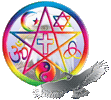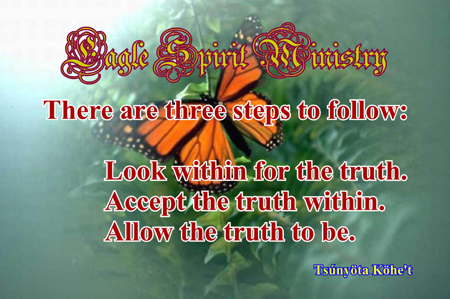 |
 |
| Adaptation of | ||||
| by Laureen Rama Presented by |
||||
 |
||||
Definition of Shamanic Practice. |
||||
|
|
||||
| Shamanic practice is an ancient practice for accessing intuitive or spiritual realms for guidance and healing. Shamanic practice is a common heritage of almost all cultures and has been around for at least 30,000 years. It is the way our ancestors expressed their spirituality and was integrated into every aspect of their lives. It is a wonderful complementary practice for almost any spiritual belief system. It is also a powerful vehicle for personal transformation. Contemporary core shamanic practice is an easy practice to learn to tap into intuition or spirit, for guidance and healing. The guidance can be helpful in addressing challenges and resolving issues. The healing is at a spiritual level and usually has profound positive effects with people becoming more self-confident, alive, and physically healthy. In my experience, 95 % of people can learn contemporary core shamanic practice within a few hours. It seems to be part of the human birthright to be able to do this; we can see this in children who are usually adept at connecting with imaginal realms. Shamanic practice uses our natural sixth sense, that many of us have lost touch with, but can easily regain. |
||||
|
|
||||
Non-ordinary Reality. |
||||
| Shamanic practice is the practice of deliberately connecting with ‘non-ordinary reality’ for guidance, power, and healing. Non-ordinary reality is present in the same time and space as ordinary reality; in which you are now reading these words, and maybe eating your lunch, but we are usually not consciously aware of it. It touches us through our intuitive hunches; we know who is calling on the phone, we feel strongly we should take another route and miss a car accident by doing so; we probably experience it in some of our dreams; it may be our own imagination or subconscious, or Jung’s collective unconscious; it is what some call the ‘spirit world’, others the ‘dreamtime’. Someone who can work with non-ordinary reality to provide guidance and healing for others, is called a shaman; a word from the Siberian Tungus tribe. Regardless of our beliefs, religious or otherwise, about non-ordinary reality, it is a realm which we can access to make our ordinary reality lives richer and more fulfilling. When we can consciously move in and out of this realm, we have access to resources that can transform our lives. |
||||

|
||||
Contemporary Core Shamanism: |
||||
| The method that I have learned, and find easy to teach, is Michael Harner’s core shamanic practice. Harner is an American anthropologist who has studied shamanic practices around the world to find what is common, or core, to all of them. They appear to be part of all cultural traditions if we go far enough back in time. Shamanism seems to be the way humans originally connected with their spirituality. The shamanic sixth sense that allowed hunters to sense where game was, or gatherers to find the medicines and food they needed and know how to use them, was essential to human survival. With the rise of organized religions and technological cultures, shamanic practices were lost or driven from many cultures. Interest in shamanic practices is occurring world-wide, as people of many cultures realize that a purely technological and material approach to life is barren and not fully human. Not recognizing the connectedness of all life has led to the destruction of many life forms on the planet and is not healthy for all other life forms living now. In searching for healthier ways to live, many are finding themselves drawn to spiritual practices that are based on recognizing the interconnectedness of all life, and that there is more to life than meets the eye; a magical dimension exists around us at all times that we can tap into to enrich our lives. When Harner discovered the power of shamanic practice during his fieldwork in the Amazon Basin more than 30 years ago, he wanted to teach this to Western people, so they would learn more compassion and respect for each other and other living things. But in many cultures, the road to becoming a shaman is long and arduous and Harner did not see Westerners as willing to go through that process. He searched to find what was core to shamanic practice around the world, so he could teach people the bare bones of accessing non-ordinary reality without any cultural trappings. He developed a synthesis of the essence of shamanic practice that is simple and easy to learn. He stresses that once you learn basic contemporary core shamanic practice, the way to learn more is to follow the guidance you receive from your own personal spirit helpers (power animals or spirit teachers) in non-ordinary reality and/or work with an experienced teacher. |
||||
 |
||||
The Shamanic Journey. |
||||
| The basic practice of contemporary core shamanism is the shamanic ‘journey’. This is an experience that is usually 10 to 20 minutes long. Rhythmic sound from a drum or rattle, or free form dance movement, guides the ‘journeyer’ into a receptive relaxed state and she has an experience like a lucid dream, which unfolds as she lays or sits quietly and travels to non-ordinary reality in her imagination. The journeyer asks questions for guidance, usually of her personal dream intermediaries or spirit helpers, who appear to be animals or people. Non-ordinary reality can look and feel like ordinary reality, or it can seem extraordinary e.g., crystal cities, giant geometric shapes. Journeying is not an out-of-body experience; one can be aware of ordinary reality surroundings. Yet, in shamanic journeys, people can swim like fish, fly over mountains, visit the spirits of people not physically present and it feels real. Everyone's experience is unique and personally meaningful to them. One can journey alone or with a group. The key to doing a shamanic journey is to have a question or an intent that is important to you. Generally, people journey when they feel the desire or need rather than on a regular basis. Although it is not the only way to connect with non-ordinary reality, the discipline of the journey is a powerful way to learn about non-ordinary reality so that other methods become easier. The best way to learn to shamanic journey is with an experienced teacher. Although one can learn it alone through reading and practicing, there are precautions and helpful measures that are best learned with someone with experience. |
||||
|
|
||||
Power Animals. |
||||
| The first task in learning contemporary shamanic practice is to connect with our power animals; the characters who are generally our ‘tour guides’ in non-ordinary reality. In shamanic cultures it is believed that we all have power animal(s) who act as our guardian spirit(s). Our power animal(s) represents our strengths, our qualities of character, our power. We may have more than one power animal, and they may change over time as our lives change and call us to have different kinds of strengths. Knowing what these animals are helps us connect with our own strengths, and infuses us with personal power. This enables us to create the lives we want. When our connection with our power animals is weak, perhaps because we are not honouring or expressing that aspect of ourselves, we can become dispirited or ill. Ways to maintain strong connections with our power animal(s), to stay healthy and powerful, are to honour them in the way that feels best. Some people carry objects that represent their power animals or have pictures of them evident. Michael Harner advocates ‘exercising’ your power animals regularly; allowing their spirit to fill your body as you dance, walk, cycle, or exercise. This gives them the gift of being embodied and allows you a bodily experience of the energy of your power animal(s). |
||||
| For more information on identifying your power animal see: | ||||
|
||||
 |
||||
Spirit Guides Or Teachers. |
||||
| All of us have spirit guides or teachers, also, who appear to be people in non-ordinary reality. They can be archetypal figures (e.g., certain gods or goddesses, Grandfather Sun), or historical figures (e.g., Jesus), people of any culture of any time period, even people we may know or have known. Many have experienced their spirit guides as the unseen voice or presence that has warned them or comforted them at critical times in their lives. Spirit guides or teachers are wise advisors from whom we can seek guidance. We can also ask our spirit teachers to help us with ordinary reality challenges (e.g., improving my relationship with so-and-so, opening my new business). If it is in the greater good, we often find miraculous support in meeting our intended goals. Our spirit helpers can give us advice, but are not there to make our decisions for us. We have free will and are intended to use it, co-creating our own and the collective experience with their spiritual assistance. |
||||
| For more information on identifying your personal spirit guides see: |
||||
|
||||
 |
||||
| Please feel free to share the text of Soul Restore, crediting Laureen Rama as the author. |
||||
 |
||||
 |
||||
 |
||||